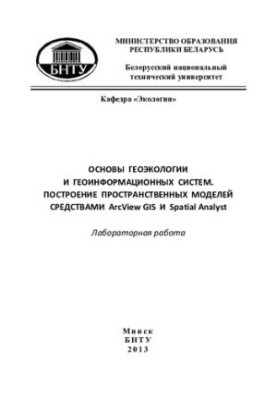Basics of geoecology and geoinformation systems. Construction of spatial models by Arc. View GIS and Spatial Analyst
 Instant download
Instant download
after payment (24/7)
 Wide range of formats
Wide range of formats
(for all gadgets)
 Full book
Full book
(including for Apple and Android)
Basics of Geoecology and Geographic Information Systems . Building spatial models by means of Arc. View GIS and Spatial Analyst by Sergey Anatolievich Laptenko is a unique and in-depth study that opens the world of geoecology and geoinformation technologies to the reader. This work will become an indispensable assistant for students, graduate students, researchers and practitioners working in the field of ecology, geography, land management and related disciplines. In his book, Laptenok invites the reader to dive into the basics of geoecology, looking at how spatial models can help in the analysis and management of natural resources. The author skillfully combines theoretical aspects with practical examples, which makes the material accessible and understandable even for those who are just starting their way in this field. The book covers a wide range of topics, including methods for collecting and analyzing geodata, the use of geoinformation systems (GIS) for solving environmental problems, and the construction of spatial models using Arc. software. View GIS and Spatial Analyst. Readers interested in ecology, geography, human ecology and sustainable development will find a lot of useful information in this book. It will be of particular interest to students and faculty working in universities and research institutions, as well as practitioners involved in environmental monitoring and natural resource management. Laptenko emphasizes the importance of integrating geographic information systems into environmental research, which emphasizes the relevance and importance of this work in the modern world. The book stands out for its distinctive style, which combines scientific rigor with the accessibility of presentation. The patch uses many illustrations, graphs and examples, which allows the reader to better absorb the material and apply the knowledge gained in practice. His approach to learning and explaining complex concepts makes the book not only useful, but also fascinating to read. The topics raised in the book cover not only the technical aspects of working with GIS, but also broader issues such as human-nature interaction, sustainable development, and ecosystem services. The patch emphasizes the importance of understanding spatial data for making informed decisions in the field of environmental protection and natural resource management. This makes the book relevant not only for specialists, but also for everyone who is interested in the future of our planet and wants to contribute to its preservation. If you are looking for literature that will help you to master the basics of geoinformation systems and their application in ecology, the "Fundamentals of geoecology and geoinformation systems" will be a real find for you. This book will not only expand your knowledge, but also inspire new research and projects. It can serve as an excellent addition to other well-known works in the field of geoecology and GIS, such as "Geoinformation Systems in Ecology" and "Environmental Informatics". In conclusion, “Fundamentals of geoecology and geoinformation systems . Building spatial models by means of Arc. View GIS and Spatial Analyst is a book that will not leave anyone indifferent who seeks to understand how modern technologies can help solve environmental problems. This work will become a reliable guide in the world of geographic information systems and will open new horizons for your professional growth and scientific research.
LF/839359954/R
Data sheet
- Name of the Author
- Лаптенок
С. А. - Language
- Russian

























